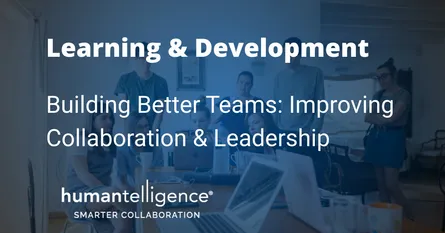
Learning development

Building Better Teams: 9 Strategies for Employee Collaboration & Leadership Development
- 06 Jan, 2025
- Collaboration
Effective collaboration and leadership are at the heart of every successful organization. In a world where remote work, cross-functional teams, and technological advancements define the workplace, companies must prioritize training that equips employees with the skills they need to excel. With the integration of AI, advanced technologies, and the tools they already use, the way organizations approach these critical skills is evolving rapidly. Here's nine of the best ways companies can train employees to collaborate more effectively and develop their leadership abilities--without extra time, budget, or manpower.1. Foster a Collaborative Culture Before diving into training programs, organizations must establish a culture where collaboration is valued and encouraged.Open Communication: Promote transparency through open-door policies, regular team check-ins, and tools like Slack or Microsoft Teams. Inclusivity: Ensure diverse voices are heard by fostering an environment of mutual respect and psychological safety. Recognition: Celebrate collaborative efforts and team successes to reinforce the value of working together.2. Leverage AI to Enhance Teamwork AI-powered tools can transform how teams collaborate, providing insights and support that weren’t possible before.Dynamic Scheduling: AI tools like Clockwise can manage calendars, minimizing scheduling conflicts to enhance meeting productivity. Real-Time Collaboration: Platforms like Miro or MURAL use AI to streamline brainstorming and visual collaboration, even in remote settings. AI-Mediated Communication for Efficiency: Tools like Grammarly or Otter.ai help improve clarity and in written and verbal communications. AI-Mediated Communication for Effectiveness: Tools like Humantelligence take communication a step further and can craft emails for inclusivity, belonging, and personalization -- all based on the personality of the recipient.3. Invest in Leadership Development Programs Leadership training should go beyond technical skills to focus on emotional intelligence, decision-making, and strategic thinking.Experiential Learning: Simulations, role-playing, and case studies can immerse employees in real-world leadership challenges. Mentorship Programs: Pair emerging leaders with seasoned mentors to foster growth through guidance and feedback. AI-Driven Feedback: Platforms like BetterUp use AI to provide personalized coaching, tracking progress in leadership behaviors.4. Adopt Technology for Skill Building Advanced technologies can make training programs more engaging and effective.Gamification: Use platforms like Kahoot! or Quizizz to gamify learning modules, increasing engagement and retention. Virtual Reality (VR): VR simulations allow employees to practice collaboration in lifelike scenarios, preparing them for high-pressure situations. Learning Management Systems (LMS): Utilize tools like Cornerstone or Udemy for Business to deliver and track employee training programs.5. Prioritize Cross-Functional Teamwork Encourage employees to work across departments to develop broader perspectives and stronger collaboration skills.Cross-Functional Projects: Assign tasks requiring input from diverse teams to build mutual understanding and break silos. AI Collaboration Tools: Tools like Trello or Monday.com streamline project management for teams with varying expertise. When you add in Humantelligence to this mix, you'll foster more effective and collaborative interactions between the people working on these projects too!6. Use AI to Identify Collaboration Gaps AI analytics can reveal bottlenecks and opportunities for improvement in team dynamics.Network Analysis: AI tools like Humanyze analyze communication patterns to highlight disconnected team members or overburdened employees. Sentiment Analysis: Platforms like Zoom IQ analyze meeting transcripts to gauge emotional tone, providing insights into team morale.7. Promote Continuous Learning Effective leadership and collaboration training aren’t one-time events but ongoing processes.Microlearning Modules: Deliver short, targeted training sessions using platforms like Axonify or Blinkist. AI-Powered Learning Paths: AI tools can customize training plans based on individual skill levels and career aspirations.8. Encourage Feedback and Iteration Feedback loops are essential for refining collaboration and leadership skills.360-Degree Feedback: Use platforms like Lattice or Leapsome for comprehensive feedback from peers, managers, and subordinates. AI-Driven Insights: AI tools analyze feedback to identify patterns and recommend actionable improvements.9. Measure Success with Data Finally, track the impact of training initiatives to ensure they’re driving results.Performance Metrics: Monitor collaboration tools for increased engagement and productivity. AI-Driven Analysis: Use AI analytics to measure changes in leadership behaviors and team dynamics over time. Employee Surveys: Regularly collect feedback to assess the effectiveness of training programs and identify areas for improvement.L&D Coaching from Anywhere The traditional approach to employee development, leadership training, and team collaboration is rapidly evolving, and companies that embrace these modern strategies will see higher engagement, retention, and overall performance. By offering personalized, on-demand learning, fostering a feedback-driven culture, and integrating learning into daily workflows, you can create an L&D program that not only meets today’s needs but is also ready for the future of work. With it, companies can create tailored, engaging, and impactful training programs. Investing in these strategies not only boosts productivity and innovation but also cultivates a workforce ready to tackle the challenges of the future.